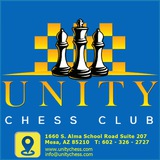📕Unity Chess Multiple Choice 349
A: Be3 – 8
👍👍👍👍👍👍👍 80%
B: N×a8 – 2
👍👍 20%
C: B×e4
▫️ 0%
👥 10 people voted so far.
A: Be3 – 8
👍👍👍👍👍👍👍 80%
B: N×a8 – 2
👍👍 20%
C: B×e4
▫️ 0%
👥 10 people voted so far.
📕Unity Chess Multiple Choice 350
C: a5 – 5
👍👍👍👍👍👍👍 42%
B: f4 – 4
👍👍👍👍👍👍 33%
A: h4 – 3
👍👍👍👍 25%
👥 12 people voted so far.
C: a5 – 5
👍👍👍👍👍👍👍 42%
B: f4 – 4
👍👍👍👍👍👍 33%
A: h4 – 3
👍👍👍👍 25%
👥 12 people voted so far.
International women's tournament at Tbilisi, April 1984. Front row, left to right: Pia Cramling, Marta Litinskaya, Elena Akhmylovskaya, Maia Chiburdanidze, Nona Gaprindashvili, Nino Gurieli... 3rd from right, back row - Nana Alexandria.
@UnityChess
@UnityChess
Candidates, Rd 12: Karjakin (4 wins, 2 loses, 6 draws) beat Caruana (3 wins, 1 loss, 8 draws) & both are now tied for 1st with 7/12. Ding Liren beat Mamedyarov, his first win, with 11 draws. Those two, plus Grischuk are tied for 3rd. Rd 13: So-Karjakin and Caruana-Aronian.
At the opening ceremony of the Women's Candidates' Semi-final, Vilnius 1980. Marta Litinskaya, Vladas Mikėnas and Nana Alexandria.
@UnityChess
@UnityChess
When V. Korchnoi defected in 1976, 31 USSR GMs signed a letter denouncing him. It included Tal, Petrosian, & Smyslov. It was not signed by Botvinnik, Karpov, or Spassky. Fischer sent a letter of congratulations to Korchnoi. The USSR stripped him of all his titles and honors.
@UnityChess
@UnityChess
This media is not supported in your browser
VIEW IN TELEGRAM
Anatoly Karpov during a game-by-television against West Germany in late 1976. Great choice of tie.
@UnityChess
@UnityChess
🔵 José Raúl Capablanca
🔵 Cuban Chess Master and World Chess Champion
♦️ José Raúl Capablanca y Graupera was a Cuban chess player who was world chess champion from 1921 to 1927.
▪️ Full name: José Raúl Capablanca y Graupera
▪️ Country: Cuba
▪️ Born: 19 November 1888
Havana, Cuba, Spain
▪️ Died: 8 March 1942 (aged 53)
New York City, New York, U.S.
▪️ World Champion: 1921–1927
♦️ Capablanca was the third World Champion, reigning from 1921 until 1927. Renowned for the simplicity of his play, his legendary endgame prowess, accuracy, and the speed of his play, he earned the nickname of the "Human Chess Machine".
♦️ Capablanca, the second son of a Spanish Army officer, was born in Havana. He learned to play at an early age by watching his father and defeated Cuban Champion Juan Corzo in an informal match in 1901 by 6.5-5.5 (+4 −3 =5), turning 13 years of age during the match. Despite this and despite taking 4th place in the first Cuban Championship in 1902, he did not focus on chess until 1908 when he left Columbia University where he had enrolled to study chemical engineering and play baseball. He did, however, join the Manhattan Chess Club in 1905, soon establishing his dominance in rapid chess. He won a rapid chess tournament in 1906 ahead of the World Champion Emanuel Lasker, and played many informal games against him. Within a year or two of dropping out of university and after playing simultaneous exhibitions in dozens of US cities, winning over 95% of his games, Capablanca had established himself as one of the top players in the world, especially after the Capablanca - Marshall (1909) New York match exhibition win 15-8 (+8 -1 =14).
♦️ A memorable game by Capablanca which known "Havana Knights" in chessgames.com site👇🏼👇🏼
🔸 Emanuel Lasker vs Jose Raul Capablanca
🔸 WCCH (1921), Havana CUB, rd 10, Apr-08
🔸 Queen's Gambit Declined: Orthodox Defense. Rubinstein Variation (D61)
♦️ Review and download annotated by Capablanka PGN file👇🏼
@unitychess
🔵 Cuban Chess Master and World Chess Champion
♦️ José Raúl Capablanca y Graupera was a Cuban chess player who was world chess champion from 1921 to 1927.
▪️ Full name: José Raúl Capablanca y Graupera
▪️ Country: Cuba
▪️ Born: 19 November 1888
Havana, Cuba, Spain
▪️ Died: 8 March 1942 (aged 53)
New York City, New York, U.S.
▪️ World Champion: 1921–1927
♦️ Capablanca was the third World Champion, reigning from 1921 until 1927. Renowned for the simplicity of his play, his legendary endgame prowess, accuracy, and the speed of his play, he earned the nickname of the "Human Chess Machine".
♦️ Capablanca, the second son of a Spanish Army officer, was born in Havana. He learned to play at an early age by watching his father and defeated Cuban Champion Juan Corzo in an informal match in 1901 by 6.5-5.5 (+4 −3 =5), turning 13 years of age during the match. Despite this and despite taking 4th place in the first Cuban Championship in 1902, he did not focus on chess until 1908 when he left Columbia University where he had enrolled to study chemical engineering and play baseball. He did, however, join the Manhattan Chess Club in 1905, soon establishing his dominance in rapid chess. He won a rapid chess tournament in 1906 ahead of the World Champion Emanuel Lasker, and played many informal games against him. Within a year or two of dropping out of university and after playing simultaneous exhibitions in dozens of US cities, winning over 95% of his games, Capablanca had established himself as one of the top players in the world, especially after the Capablanca - Marshall (1909) New York match exhibition win 15-8 (+8 -1 =14).
♦️ A memorable game by Capablanca which known "Havana Knights" in chessgames.com site👇🏼👇🏼
🔸 Emanuel Lasker vs Jose Raul Capablanca
🔸 WCCH (1921), Havana CUB, rd 10, Apr-08
🔸 Queen's Gambit Declined: Orthodox Defense. Rubinstein Variation (D61)
♦️ Review and download annotated by Capablanka PGN file👇🏼
@unitychess
@unitychess Lasker-Capablanca 1921.pgn
3.2 KB
🔹 Emanuel Lasker - Jose Raul Capablanca, WCCH 1921/ game 10
🔹 PGN format
🔹 Annotated by Capablanca
@unitychess
🔹 PGN format
🔹 Annotated by Capablanca
@unitychess
